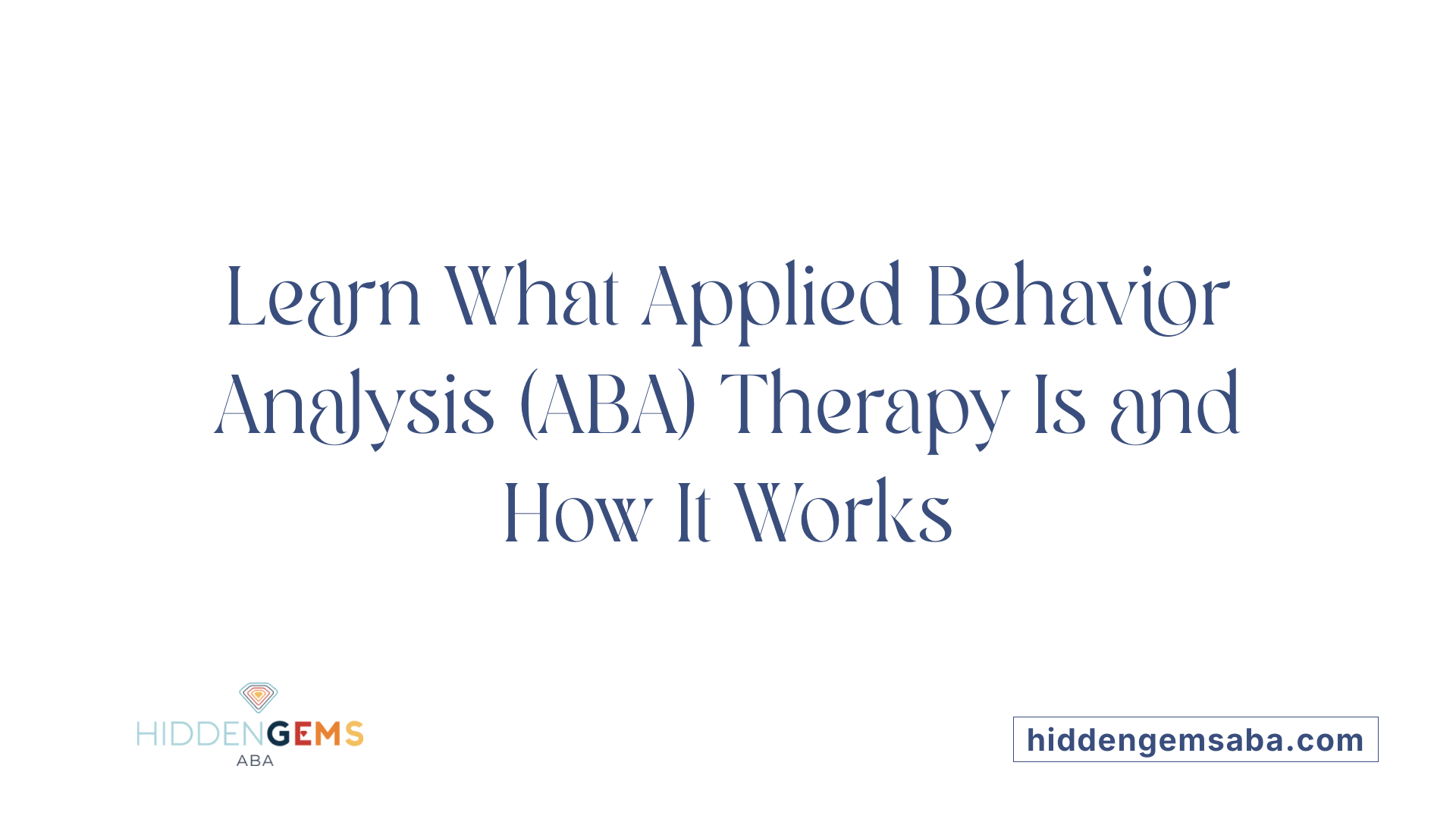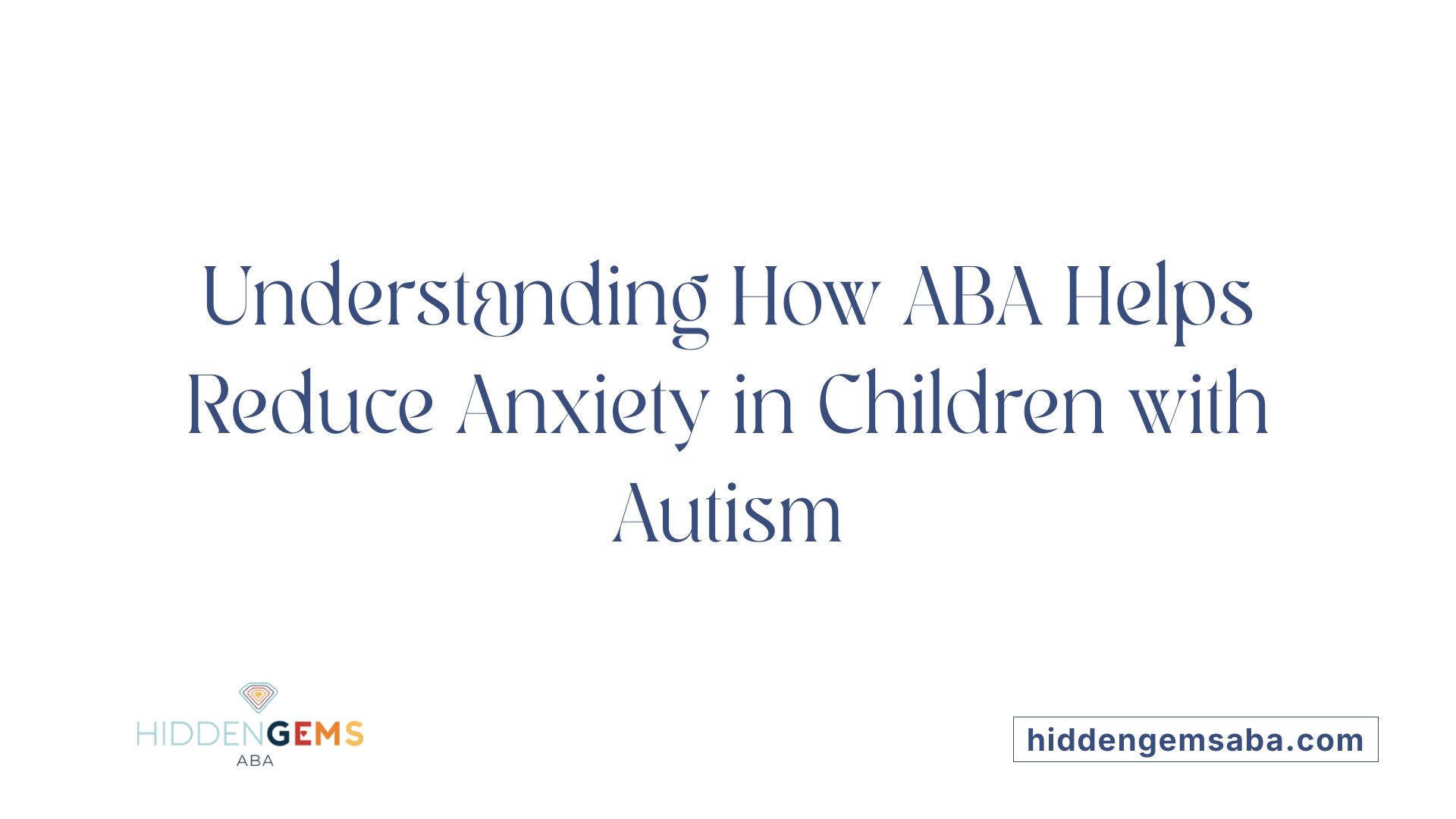Understanding the Intersection of Autism, Anxiety, and ABA Therapy
Anxiety is a common challenge among children with autism spectrum disorder (ASD), impacting their daily lives and overall well-being. Applied Behavior Analysis (ABA) therapy, a scientifically validated approach, offers hope by addressing behavioral and emotional challenges through individualized, evidence-based methods. This article explores how ABA therapy is employed to support children with autism in managing anxiety, enhancing communication, and developing coping skills, thereby improving their quality of life.
What is Applied Behavior Analysis (ABA) Therapy?

Definition and Principles of ABA Therapy
Applied Behavior Analysis (ABA) therapy is an evidence-based approach designed to support individuals, particularly children with autism and similar developmental challenges. It is rooted in the scientific study of behavior and learning. By focusing on observable behaviors and their relationship with the environment, ABA helps improve communication, social skills, and daily living abilities, while reducing problematic behaviors.
Use of the ABC Model
A core element of ABA is the ABC model, which stands for Antecedent, Behavior, and Consequence. This framework helps therapists analyze what triggers a behavior (antecedent), the behavior itself, and what follows that behavior (consequence). Understanding this sequence is essential for modifying behaviors effectively and reinforcing positive actions.
Methods of Behavior Modification
ABA primarily uses positive reinforcement techniques to encourage desired behaviors. For example, verbal praise or access to preferred activities are common rewards. Therapists avoid punitive measures, focusing instead on motivating children through supportive and compassionate strategies. Techniques include prompting, shaping, and chaining skills, allowing children to gradually acquire more complex abilities.
Individualized Treatment Plans
Each ABA therapy program is tailored to the individual child's needs and strengths. Certified Behavior Analysts (BCBAs) conduct comprehensive assessments to identify specific goals, such as enhancing language skills or promoting independence. Treatments are delivered in natural environments like homes or schools and are continuously monitored and adjusted to ensure progress. Collaborating with families is a vital part of the process to set realistic objectives and maintain consistent support.
Overall, ABA therapy serves as a structured yet flexible intervention, empowering children with autism to reach their full potential through personalized, compassionate care grounded in behavioral science.
How ABA Therapy Addresses Anxiety in Children with Autism

Understanding anxiety in children with autism
Children with autism often experience anxiety, which can affect their daily functioning and quality of life. Anxiety may manifest through behaviors such as avoidance, repetitive actions, or meltdowns. Recognizing these signs is crucial in providing appropriate support.
ABA strategies for anxiety management
ABA therapy uses the ABC model—Antecedent, Behavior, Consequence—to understand the triggers and responses related to anxiety. By analyzing what happens before (antecedent) and after (consequence) anxiety-driven behaviors, therapists can adapt the environment and teaching strategies to reduce anxiety-provoking situations.
Development of healthier coping mechanisms
ABA supports children in learning new skills that promote independent coping. Through individualized plans, therapists help children replace maladaptive behaviors with constructive alternatives. These interventions promote resilience and self-regulation in challenging situations.
Role of positive reinforcement
Positive reinforcement is central to ABA therapy, especially in managing anxiety. By rewarding desired behaviors with praise or access to preferred activities, children are encouraged to adopt healthier responses. This compassionate and ethical approach respects the child's autonomy and fosters motivation.
Overall, ABA therapy’s personalized, evidence-based methods make it effective for reducing anxiety and enhancing overall wellbeing in children with autism.
Key Goals and Benefits of ABA Therapy for Autism and Anxiety

What Are the Main Goals and Benefits of ABA Therapy for Individuals on the Autism Spectrum?
ABA therapy is designed to increase positive and functional behaviors while reducing challenging or problematic behaviors. Its primary goals include enhancing communication skills, social interaction, self-care, and academic abilities. By focusing on these areas, ABA helps individuals on the autism spectrum gain greater independence and improve their overall quality of life.
Improvement in Communication and Social Skills
One of the standout benefits of ABA therapy is the development of effective communication skills. This can range from basic gestures and vocalizations to more complex conversations depending on the child’s needs. ABA also targets social skills, encouraging children to engage with others appropriately and build meaningful relationships.
Reduction of Problematic and Anxiety-Related Behaviors
ABA uses the ABC model—Antecedent, Behavior, Consequence—to understand why problematic behaviors occur and then applies positive reinforcement techniques to reduce them. This approach extends to anxiety-related behaviors by teaching healthier coping mechanisms and replacing harmful reactions with more adaptive responses.
Enhancement of Independence and Coping Skills
By focusing on life skills such as dressing, eating, and managing personal hygiene, ABA therapy supports greater self-reliance. Children also learn coping skills essential for handling everyday stressors, which contributes to their emotional well-being.
Quality of Life Improvements
Early and individualized intervention through ABA therapy leads to meaningful improvements in a child’s academic performance and social adaptability. The therapy is personalized and regularly adjusted in collaboration with families to meet specific needs and goals, ensuring that each child can reach their fullest potential.
| Goal Area | Benefits | Description |
|---|---|---|
| Communication Skills | Improved speech & language usage | Helps children express needs and ideas clearly |
| Social Skills | Better interaction & friendships | Encourages appropriate social behaviors and relationships |
| Behavioral Management | Reduced problem behaviors | Uses positive reinforcement to decrease unwanted actions |
| Independence Skills | Enhanced self-care & daily living | Teaches essential life skills for greater autonomy |
| Emotional Coping | Healthier stress response | Develops strategies to manage anxiety and emotional challenges |
| Academic Skills | Increased focus and learning | Supports skills leading to better school performance |
The Role of Qualified Professionals in Delivering ABA Therapy
Types of ABA practitioners
ABA therapy services are primarily administered by professionals possessing specialized training in behavioral analysis. Board Certified Behavior Analysts (BCBAs) are the principal providers tasked with creating and overseeing individualized treatment plans. They ensure interventions are tailored to each child's unique needs. Supporting BCBAs are Registered Behavior Technicians (RBTs) and licensed therapists who implement daily therapy sessions under BCBA supervision. These practitioners typically work within organizations dedicated to high standards of care.
Importance of credential verification
Verifying practitioner credentials is crucial when choosing ABA therapy providers. Certification such as BCBA or registration as an RBT guarantees that the provider has met rigorous educational, ethical, and practical experience requirements. Ensuring a provider’s credentials protects families by affirming professional accountability, adherence to evidence-based practices, and a commitment to ongoing professional development.
Collaborative approach with families
Effective ABA therapy involves close collaboration with families. Qualified practitioners engage parents and caregivers in every stage of the process—from comprehensive assessments and goal setting to routine progress reviews. This team effort equips families with strategies to support skill development beyond therapy sessions and fosters consistency in the child's environment, enhancing overall outcomes.
Ensuring ethical and compassionate practices
Ethics and compassion form the foundation of ABA therapy delivery. Qualified professionals uphold respect for the child’s dignity and autonomy, employing positive reinforcement methods such as verbal praise and access to preferred activities rather than punitive approaches. Ethical standards guide these providers to create safe, supportive environments that honor each child’s individuality throughout intervention.
The Importance of Early and Intensive Intervention for Managing Anxiety in Autism
Optimal Ages for ABA Therapy Start
Starting ABA therapy early is crucial, especially for children with autism. Intervention typically begins between the ages of two and three, although early efforts up to age ten can still deliver substantial benefits. Early treatment targets developmental windows when children are more receptive to learning new communication and social skills, which can significantly reduce anxiety and other behavioral challenges.
Intensity and Duration of Therapy
ABA therapy is most effective when delivered intensively, usually ranging from 10 to 40 hours weekly. Comprehensive programs involve 25 to 40 hours per week, providing children with consistent learning and behavior modification opportunities. Therapy duration often spans several months to multiple years, with longer and more frequent engagement linked to greater progress in communication, behavior, and independence.
Impact on Developmental and Behavioral Outcomes
The combination of early start and sustained intensity improves language acquisition, social interaction, and coping strategies. This careful, structured intervention helps children manage anxiety and reduces problematic behaviors by reinforcing adaptive responses. The greater the intensity and duration, the more likely the child will achieve measurable gains in daily functioning and emotional regulation.
Long-Term Benefits of Sustained Intervention
Sustained ABA therapy over years promotes lasting improvements. Long-term commitment supports skill generalization across settings and enhances independence, academic success, and overall quality of life. Families involved in the process also benefit from collaborative goal setting and ongoing support, reinforcing skills that help manage anxiety effectively over time.
| Aspect | Details | Significance |
|---|---|---|
| Age to Start | Ideally between 2-3 years; benefits up to age 10 | Early ages yield stronger, more lasting progress |
| Intensity | 10-40 hours/week, with 25-40 hours ideal | Intensive therapy promotes skill mastery |
| Duration | Several months to multiple years | Longer therapy results in improved outcomes |
| Developmental Outcomes | Improved communication, social skills, coping mechanisms, and reduced anxiety | Enhanced daily functioning and emotional health |
| Long-Term Benefits | Increased independence, academic performance, and quality of life | Sustained gains beyond therapy period |
Tailoring ABA Therapy to Individual Needs and Family Collaboration

Personalized treatment plans
ABA therapy is designed to meet each child's unique needs through personalized treatment plans. These plans stem from comprehensive assessments that identify the specific challenges and strengths of the child. By focusing on individual characteristics, practitioners create strategies that effectively promote communication, social skills, and adaptive behaviors.
Ongoing assessment and program adjustments
A hallmark of high-quality ABA therapy is continual monitoring and adjustment. Therapists regularly evaluate the child's progress, allowing them to refine and adapt interventions as needed. This dynamic approach ensures that the therapy remains effective and responsive to the child’s development over time.
Involving families in goal-setting
Family involvement is central to successful ABA programs. Therapists collaborate with family members to set meaningful goals tailored to the child's daily life and long-term success. This partnership empowers families to support behavioral changes and skill acquisition, reinforcing progress outside of formal therapy sessions.
Supporting skill generalization across settings
ABA therapy emphasizes generalizing newly learned skills to different environments, such as home, school, and community settings. This broader application helps children maintain and use their skills in various situations, promoting independence and a higher quality of life.
Ethical and Compassionate Practice in ABA Therapy for Anxiety and Autism

Respect for Autonomy and Dignity
ABA therapy is grounded in ethical principles that prioritize the client's autonomy and dignity. Practitioners ensure that individuals, whether children or adults, are treated with respect throughout the therapeutic process. This focus helps clients feel valued and understood, fostering trust and cooperation.
Use of Positive Reinforcement Rather Than Punitive Methods
A distinguishing feature of ABA therapy is its reliance on positive reinforcement techniques. These include verbal praise, tokens, and access to preferred activities, which encourage desired behaviors without using punishment. This approach not only promotes skill acquisition but also builds motivation and a positive attitude toward learning.
Ensuring Client-Centered Care
ABA therapy programs are tailored to meet each client’s unique needs, involving collaboration with families or caregivers to set meaningful treatment goals. This individualized planning ensures that therapy is relevant, achievable, and aligned with the client’s personal and developmental goals.
Creating Supportive and Motivating Therapy Environments
Therapeutic settings in ABA emphasize natural environments and supportive conditions that motivate clients. By integrating therapy into everyday routines and providing consistent encouragement, ABA creates a nurturing atmosphere where clients are empowered to practice new skills and gradually build independence.
Harnessing ABA Therapy for Lasting Anxiety Relief in Children with Autism
ABA therapy stands out as a powerful tool for addressing anxiety in children with autism, combining evidence-based methods with compassionate, individualized care. By focusing on functional skills, communication, and adaptive behaviors, ABA empowers children to manage anxiety and improve their quality of life. The involvement of qualified professionals and families ensures therapy is tailored and ethically grounded, maximizing potential for meaningful progress. Early and sustained intervention is key to unlocking these benefits, offering hope and tangible improvement to many children and their families on the autism spectrum.
References
- Benefits of ABA Therapy
- What Is Autism Spectrum Disorder?
- Is ABA Therapy Only For Autism? Myths About ABA
- An evaluation of the effects of intensity and duration on ...
- How Much ABA is Enough?
- Understanding ABA Therapy Duration & Progress
- Applied Behavior Analysis (ABA)
- The Top 10 Reasons Children With Autism Deserve ABA
- Applied Behavior Analysis (ABA)
- 6 Benefits of ABA Therapy for Children with Autism





